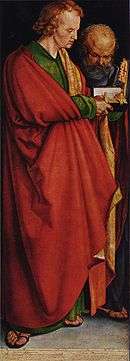The Four Apostles


The Four Apostles is a panel painting by the German Renaissance master Albrecht Dürer. It was finished in 1526, and is the last of his large works. It depicts the four apostles larger-than-life-size. The Bavarian Elector Maximilian I obtained The Four Apostles in the year 1627 due to pressure on the Nuremberg city fathers. Since then, the painting has been in Munich and, despite all the efforts of Nuremberg since 1806, it has not been returned.
Description
_-_WGA07027.jpg) | |
|
|
When Dürer moved back to Nuremberg he produced many famous paintings there, including several self-portraits. He gave The Four Apostles to the town council. Saints John and Peter appear in the left panel; the figures in the right panel are Saints Mark and Paul. Mark and Paul both hold Bibles, and John and Peter are shown reading from the opening page of John's own Gospel. At the bottom of each panel, quotations from the Bible are inscribed.[1]
The apostles are recognizable by their symbols:
- St. John the Evangelist: open book
- St. Peter: keys
- St. Mark: scroll
- St. Paul: sword and closed book
They are also associated with the four temperaments.
- St. John: sanguine
- St. Peter: phlegmatic
- St. Mark: choleric
- St. Paul: melancholy
Historical context
The Four Apostles was created during the Reformation, begun in 1517 and having the largest initial impact on Germany. As it was a Protestant belief that icons were contradictory to the Word of God, which was held in the utmost supremacy over Protestant ideas, the Protestant church was not a patron of any sacred art. Therefore, any Protestant artist, like Dürer became, had to commission their own works. Many aspects of the image depicted prove significant in light of the Reformation itself.[1]
See also
- Portrait of Jakob Muffel - A Dürer painting of the same year
References
- 1 2 "Dürer's Four Apostles". Smarthistory at Khan Academy. Retrieved December 18, 2012.
External links
![]() Media related to Four Apostles by Dürer at Wikimedia Commons
Media related to Four Apostles by Dürer at Wikimedia Commons
